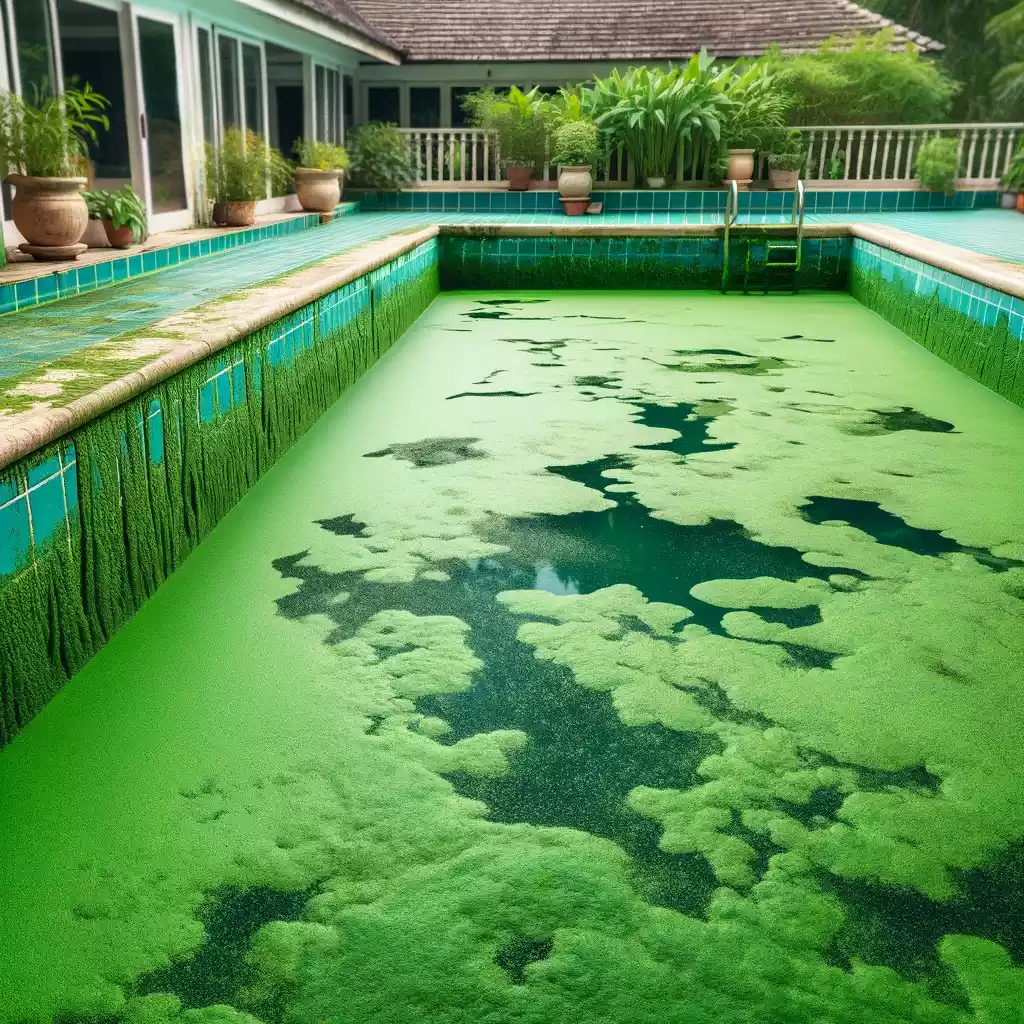One of the common nuisances in pools is the proliferation of green algae. Green algae not only affect water quality but can also lead to slippery pool bottoms and unclear water surfaces, causing inconvenience to pool users. To maintain a consistently clear and transparent pool, it is essential to understand how to eliminate and prevent green algae in pools. This article delves into effective methods for clearing and preventative measures to ensure the pool remains refreshing and pleasant at all times.

Clearing Algae – Method 1:
- Check Chlorine Levels:
- If the pool water appears green or shows signs of algae clusters, it indicates insufficient chlorine levels.
- Test the chlorine levels; if below the standard, supplement with a significant amount of chlorine.
- Shock the Pool with Chlorine:
- Shocking the pool with a substantial amount of chlorine is the most effective method to kill accumulated algae and restore pool hygiene.
- This process typically takes 1-3 days, and in poor pool conditions, it might require a longer duration.
- Brush Pool Walls and Floor:
- Use a pool-appropriate brush to remove as much algae as possible, paying attention to areas like pool walls, floor steps, and behind ladders.
- This step can expedite the time required to eliminate and clear algae.
- Check Chemical Safety:
- Read safety information on chemical labels.
- Wear gloves, goggles, and protective clothing covering the skin.
- Avoid inhaling chemicals, especially in windy weather.
- Adjust Pool pH:
- Use a pool pH test kit to measure the water’s pH.
- If the pH is above 7.6, add pH reducer following label instructions to target a pH range of 7.2 to 7.6.
- Choose Chlorine Shock Agents:
- Use liquid chlorine specifically designed for pools, containing sodium hypochlorite, calcium hypochlorite, or lithium hypochlorite.
- Ensure not to use granular or tablet chlorine with stabilizers that should not be heavily introduced into the pool.
- Additional Dose of Shock Agent:
- Following the “shock” instructions on the chlorine agent label, use twice the recommended dose for regular shock treatment.
- Apply at night and let it sit overnight to enhance effectiveness.
- Re-test Pool the Next Day:
- After running the pool filter for 12-24 hours, re-test the pool.
- Check new chlorine levels and pH, ensuring chlorine is within the appropriate range.
- Brush and Test Daily:
- Brush pool walls daily to prevent new algae growth.
- Test chlorine levels and pH daily to maintain water quality within acceptable ranges.
- Vacuum Killed Algae:
- Once the water is algae-free, use a vacuum cleaner to remove all killed algae until the water is clear.
- Optional: Add coagulants or flocculants to help algae gather together.
- Clean the Filter:
- For deep water efficient filters, backwash thoroughly.
- For cartridge filters, remove and rinse cartridges with a high-pressure hose, or wash with diluted muriatic acid or liquid chlorine if necessary.
- Thoroughly clean the filter to prevent dead algae from clogging it.
Clearing Algae – Method 2:
- Improve Circulation System:
- Check for clusters of algae, especially in stagnant areas of the pool.
- Ensure water jets are directing at an angle to create a spiraling water movement.
- Enhance the circulation system to evenly distribute pool water, preventing algae from gathering in specific areas.
- Use Flocculants to Aggregate Algae:
- If algae form clusters, use flocculants or coagulants to gather them together.
- After aggregation, quickly vacuum the gathered algae; this process may take a day.
- Note that swimming during this stage is not safe due to potential bacterial and viral growth accompanying algae reproduction.
- Disinfect the Pool with Chlorine Shock:
- After clearing aggregated algae, perform a chlorine shock to thoroughly disinfect the pool.
- Refrain from swimming until chlorine levels and pH return to normal to prevent bacterial and viral growth.
- Use Algaecides for Pool Treatment:
- Algaecides are chemicals effective in killing algae in water.
- Considerations:
- Some algaecide products may not effectively treat existing algae clusters, especially with black algae. Consult pool supply store staff or choose a product with an active ingredient concentration of 30% or higher.
- Quaternary ammonium algaecides are cost-effective but may cause foaming in the pool, which some people dislike.
- Copper-based algaecides are more effective but expensive and may dirty the pool walls.
- Wait at least 24 hours after adding algaecide before introducing other chemicals.
Preventing Algae Growth
- Maintain Pool Water:
- Keep the pool water covered with chemical agents to prevent algae growth.
- Regularly test parameters such as free chlorine levels, pH, alkalinity, and cyanuric acid.
- Daily testing is ideal, especially in seasons prone to algae growth. Test at least twice a week during the swimming season.
- Use Algaecides as Preventative Measures:
- When the pool is in normal condition, use a small dose of algaecide weekly to prevent algae growth.
- Refer to the algaecide product label for usage instructions.
- Follow regular prevention guidelines to avoid excessive algae growth, preventing potential pollution and foam formation.
- Eliminate Phosphates:
- Algae feed on various nutrients in the water, especially phosphates.
- Use a phosphate test kit to detect phosphate levels in the pool.
- If phosphates are detected, purchase commercial-strength phosphate remover from a pool supply store.
- After a couple of days, use a filter and mechanical arm or manually vacuum to remove the phosphate remover.
- Implement shock treatment after reaching reasonable phosphate levels; opinions on safe phosphate levels may vary among pool experts, but 300 ppm should generally be considered low unless algae problems persist.
Additional Tips
- Heat and sunlight can degrade chlorine and promote algae growth. Monitor chlorine levels closely, especially in hot and sunny weather.
- During winter, use a mesh pool cover to prevent debris from entering the pool, allowing only water to pass through.
- If time permits, add pool chemicals in recommended amounts gradually, adding the remaining portions if necessary after a few hours. This reduces the risk of overdosing but increases the complexity of further adjustments.
- Throughout the process, closely monitor the pool filtration system. Thoroughly backwash or clean the filter whenever the pressure is 10 psi above the normal operating pressure.
- Warning: Do not use the swimming pool until algae are eradicated, and chlorine levels in the pool water are restored to a safe level of 4 ppm or lower.
This comprehensive guide provides detailed steps for clearing and preventing algae in swimming pools, ensuring a consistently clean and enjoyable swimming environment.
 Instant
Quote
Instant
Quote Email
Us
Email
Us